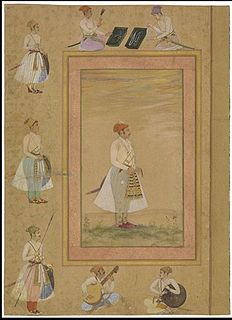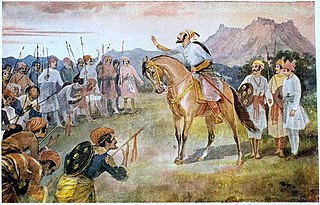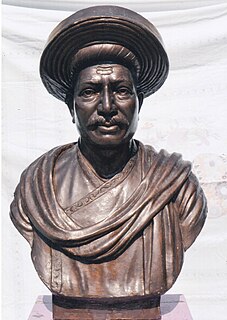
Muhi-ud-Din Muhammad, commonly known by the sobriquet Aurangzeb or by his regnal title Alamgir, was the sixth Mughal emperor, who ruled over almost the entire Indian subcontinent for a period of 49 years. Widely considered to be the last effective ruler of the Mughal Empire, Aurangzeb compiled the Fatawa-e-Alamgiri, and was among the few monarchs to have fully established Sharia law and Islamic economics throughout the Indian subcontinent. He was an accomplished military leader whose rule has been the subject of praise, though he has also been described as the most controversial ruler in Indian history.

Shivaji Bhonsale I, also referred to as Chhatrapati Shivaji, was an Indian ruler and a member of the Bhonsle Maratha clan. Shivaji carved out an enclave from the declining Adilshahi sultanate of Bijapur that formed the genesis of the Maratha Empire. In 1674, he was formally crowned the Chhatrapati (emperor) of his realm at Raigad.

Sambhaji Bhosale was the second Chhatrapati of the Maratha Empire, who ruled from 1681 to 1689. He was the eldest son of Shivaji, founder of the Marathas. Sambhaji's rule was largely shaped by the ongoing wars between the Maratha kingdom and Mughal Empire as well as other neighbouring powers such as the Siddis, Mysore and the Portuguese in Goa. In 1689, Sambhaji was captured, tortured and executed by the Mughals. He was succeeded as Chhatrapati by his brother, Rajaram I.

Netaji Palkar (1620–1681) was a Sardar Senapati or Sarnaubat (Commander-in-Chief) under Chhatrapati Shivaji Maharaj, founder of the Maratha empire.

Murarbaji Deshpande was a general in the early Maratha Empire during the reign of Chatrapati Shivaji Maharaj. He is best remembered for his defense of the Purandar Fort against Dilir Khan, a Mughal general who accompanied Mirza Raja Jai Singh in the 17th-century siege on Purandar.

Rajaram Bhosle I was the second son of Maratha emperor Shivaji, and younger half-brother of Sambhaji. He took over the Maratha Empire as its third Chhatrapati after his brother's death at the hands of the Mughal emperor Aurangzeb in 1689. His eleven-year reign was marked with a constant struggle against the Mughals.

The Mughal–Maratha Wars, also called The Deccan War or The Maratha War of Independence, were fought between the Maratha Empire and the Mughal Empire from 1680 to 1707.

Mirza Raja Ram Singh I was the elder son of Mirza Raja Jai Singh I and was the ruler of Amber, and head of the Kachwaha Rajput clan, from 1667 to 1688. He was subehdar of Kashmir from 1675-1680.

The Treaty of Purandar was signed on June 11, 1665, between the Jai Singh I, who was commander of the Mughal Empire, and Shri Chhatrapati Shivaji Maharaj. Shivaji was forced to sign the agreement after Jai Singh besieged Purandar fort. When Shivaji realised that war with the Mughal Empire would only cause damage to the empire and that his men would suffer heavy losses, he chose to make a treaty instead of leaving his men under the Mughals.
Battle of Surat, also known as the Sack of Surat, was a land battle that took place on January 5, 1664, near the city of Surat, Gujarat, India between Maratha ruler Chatrapati Shivaji Maharaj and Inayat Khan, a Mughal captain. The Marathas defeated the Mughal force, and sacked the city of Surat for six days.

Mirza Abu Talib, better known as Shaista Khan was a general and the subahdar of Mughal Bengal. A maternal uncle to the emperor Aurangzeb, he acted as a key figure during his reign. Shaista Khan initially governed the Deccan, where he clashed with the Maratha ruler Shivaji. However, he was most notable for his tenure as the governor of Bengal from 1664 to 1688. Under Shaista Khan's authority, the city of Dhaka and Mughal power in the province attained its greatest heights. His achievements include constructions of notable mosques such as the Sat Gambuj Mosque and masterminding the conquest of Chittagong. Shaista Khan was also responsible for sparking the outbreak of the Anglo-Mughal War with the English East India Company.

Jai Singh I was a senior general of the Mughal Empire and the Raja of the Kingdom of Amber. His predecessor was Raja Bhau Singh who ruled 1614-1621.

Torna Fort, also known as Prachandagad, is a large fort located in Pune district, in the Indian state of Maharashtra. It is historically significant because it was the first fort captured by Shivaji Maharaj in 1646, at the age of 16. The hill has an elevation of 1,403 metres (4,603 ft) above sea level, making it the highest hill-fort in the district. The name derives from Prachanda and gad.

Ramchandra Neelkanth Bawadekar (1650–1716), also known as Ramchandra Pant Amatya, served on the Council of 8 as the Finance Minister (Amatya) to Emperor (Chhatrapati) Shivaji dating from 1674 to 1680. He then served as the Imperial Regent to four later emperors, namely Sambhaji, Rajaram, Shivaji II and Sambhaji II. He authored the Adnyapatra, a famous code of civil and military administration, and is renowned as one of the greatest civil administrators, diplomats and military strategists of the Maratha Empire.
Battle of Umberkhind took place on 3 February 1661 in the mountain range of Sahyadri near the city of Khopoli, Maharashtra, India. The battle was fought between the Maratha army under Chatrapati Shivaji Maharaj and General Kartalab Khan of the Mughal Empire. The Marathas defeated the Mughal forces. This battle was a great example of guerrilla warfare. On the orders of Aurangzeb, Shahista Khan sent Kartalab Khan and Rai Bagan to attack Rajgad Fort. Shivaji's men encountered them in a forest in the mountain hills, which was called the Umberkhind.

The Siege of Bijapur began in March 1685 and ended in September 1686 with a Mughal victory. The siege began when the Aurangzeb dispatched his son Muhammad Azam Shah with a force of nearly 50,000 men to capture Bijapur Fort and defeat Sikandar Adil Shah, the then ruler of Bijapur who refused to be a vassal of the Mughal Empire. The siege of Bijapur was among the longest military engagements by the Mughals, lasting more than 15 months until Aurangzeb personally arrived to organize a victory.
The Battle of Purandar was fought between the Mughal Empire and Maratha Empire in 1665. The Mughal Emperor, Aurangzeb, sent his general Jai Singh to besiege Shivaji's fortress at Purandar. After Mughal forces killed Maratha General Murarbaji on June 2nd, 1665, Shivaji surrendered and gave up 23 of his fortresses. Most of the fortresses were later recaptured by Marathas.
Sarja is a Marathi film, directed by Rajdutt. It is based on a novel Shelar Khind by Marathi writer Babasaheb Purandare. It is a story of a young brave man and his wife, who assist Maratha Shivaji and his forces in capturing a fort from a Mughal Sardar.
Savitribai Deshmukh, better known by her title Rai Bagan or Raibagan, was a female Mughal general under the emperor Aurangzeb. She was the widow of the Mughal sardar Raje Udaram Deshmukh of Mahur jagir in Deccan. After her son's death in Battle of Samugarh, she led her forces aiding the then prince Aurangzeb in the battle, which paved his way to become the emperor. The emperor conferred upon her the royal title. She aided Aurangzeb's uncle Shaista Khan in the Mughal campaign against the Maratha founder Shivaji.

Khemirao Sarnaik also known as Kheni Sirnayak was a Koli Deshmukh of the Maval region during the time of Shivaji's rule and had taken up arms against Mughal Sultan Aurangzeb and abolished Jizya. he belongs to the Thorat clan of Mahadev Kolis of Maharashtra. Sarnaik played an important role in Shivaji's power, defeating the Bijapur Sultanate and establishing the Maratha Empire. When shivaji began his revolts in following decades, the kolis were amongst the first to join shivaji under Khemirao Sarnaik.














